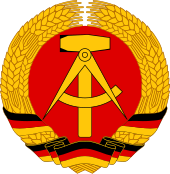
Back فولكسكامر Arabic Cámara Popular AST Фолкскамер Bulgarian Cambra del Poble Catalan Volkskammer Danish Volkskammer German Φολκσκάμμερ Greek Volkskammer EO Cámara Popular Spanish Volkskammer Finnish
People's Chamber Volkskammer | |
|---|---|
| German Democratic Republic | |
 | |
| Type | |
| Type | |
| History | |
| Founded | 7 October 1949 |
| Disbanded | 3 October 1990 |
| Preceded by | Reichstag (Nazi Germany) 1933–1945 Länderkammer (East Germany) 1949–1958 |
| Succeeded by | Bundestag |
| Leadership | |
President | |
Vice President/Deputy President | (first presidium) Hermann Matern Gerald Götting Ernst Goldenbaum Heinrich Homann Vincenz Müller (last presidium) Reinhard Höppner Käte Niederkirchner Jürgen Schmieder Wolfgang Ullmann Stefan Gottschall |
| Seats | 400 |
| Elections | |
First election | 15 October 1950 |
Last election | 18 March 1990 |
| Meeting place | |
 | |
| Palace of the Republic, Berlin | |
| Constitution | |
| Constitution of East Germany | |
 |
|---|
The Volkskammer (German: [ˈfɔlkskamɐ], "People's Chamber") was the supreme power organ of East Germany. It was the only branch of government in the state, and per the principle of unified power, all state organs were subservient to it.
The Volkskammer was initially the lower house of a bicameral legislature. The upper house was the Chamber of States, or Länderkammer, but in 1952 the states of East Germany were dissolved, and the Chamber of States was abolished in 1958. Constitutionally, the Volkskammer was the highest organ of state power in the GDR, and both constitutions vested it with great lawmaking powers. All other branches of government, including the judiciary, were responsible to it. By 1960, the chamber appointed the State Council (the GDR's collective head of state), the Council of Ministers (the GDR's government), and the National Defence Council (the GDR's collective military leadership).
In practice, however, it was a rubber stamp parliament that did little more than ratify decisions already made by the SED Politburo. By the 1970s and before the Peaceful Revolution, the Volkskammer only met two to four times a year.[1]
Cite error: There are <ref group=note> tags on this page, but the references will not show without a {{reflist|group=note}} template (see the help page).
- ^ Pötzl, Norbert F. (18 March 2020). "Letzte DDR-Volkskammer-Wahl vor 30 Jahren: Sieg der D-Mark". Der Spiegel (in German). ISSN 2195-1349. Retrieved 9 November 2023.